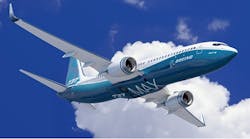Boeing Co.’s sales slumped as jet deliveries fell to the lowest in three years, ahead of the impending debut of a new version of the company’s best-selling plane.
Revenue dropped 7.3% to $21 billion in the first quarter, about $200 million less than analysts had estimated. Weak sales overshadowed a surprise gain in free cash flow as the manufacturer kept costs in check and started to reap a long-awaited payoff from the 787 Dreamliner.
The report spotlighted Boeing’s need to make its factories more efficient as it girds for a slowing aerospace market. While the Chicago-based manufacturer raised its forecast for 2017 earnings because of improved tax expectations, it didn’t boost the cash outlook -- a crucial number for investors as aircraft orders fade late in a sales cycle that began more than a decade ago.
“The stock has been a high flier for a while,” George Ferguson, an analyst at Bloomberg Intelligence, said on April 26. “People clearly had high expectations and this was a middling report.”
The shares fell 1.2% to $181.23 at 10:09 a.m. in New York, the second-biggest drop among the 30 members of the Dow Jones Industrial Average. Boeing rose 18% this year through April 25.
Commercial Margins
Boeing had indicated the quarter would be the weakest of the year. Even so, the company posted the lowest profit margin for its commercial jetliner business since the first quarter of 2011 after excluding accounting charges, Seth Seifman, an analyst at JPMorgan Chase & Co., said in a note to clients. While Boeing’s earnings were better than analysts predicted, most of the gain was driven by taxes and not operations, he said.
The commercial airplane business posted an operating profit of $1.22 billion, an 18% gain from a year earlier, as services sales helped soften the impact from seven fewer jetliner deliveries. Boeing delivered 169 commercial jets, the fewest since the first quarter of 2014, as it began to stockpile 737 Max jets ahead of the initial delivery of the upgraded narrow-body next month.
The 8.5% operating margin for the unit was well below the mid-double-digits goal that Boeing CEO Dennis Muilenburg has set for late decade.
“Commercial profits were a little lighter than I would’ve expected,” said Howard Rubel, managing director at Jefferies.
The defense business’s profit fell 10 percent to $737 million, as the company’s space business spent to develop satellites and a capsule to haul humans to space. The division’s operating margin rose to 11.3 percent from 10.3 percent. The second-largest U.S. defense contractor is poised to enjoy gains as the U.S. Navy orders F/A-18 Super Hornets to fill a gap created by late deliveries of Lockheed Martin Corp.’s F-35C fighter.
New 737
Boeing plans to cut output of the 777, long its second-largest source of profit, for a second time later this year. The 787 Dreamliner should help dull some of the pain and Boeing will also gain as initial deliveries start next month for the 737 Max, the newest member of its most profitable jet family, Ferguson said.
Deferred production costs for the 787 fell $316 million to $27 billion from the previous quarter. The balance of deferred costs has started to shrink with each 787 that rolls out of Boeing’s factories. It represents the money the company sank into inventory and manpower after the Dreamliner entered the market three years late following a series of production and supply-chain breakdowns.
Boeing has promised a steep improvement in cash and savings from the Dreamliner as it refines the plane’s manufacturing process, builds more higher-margin models like the 787-9 and no longer has to compensate customers for late deliveries. The marquee aircraft, with a frame made of spun carbon-fiber, emerged as a money maker for Boeing last year after a decade of losses.
Cash Flow
First-quarter free cash flow of $1.63 billion contrasted with the average analyst estimate that the planemaker would consume $137 million during what’s typically the company’s slowest period. Earnings adjusted for pension expenses were $2.01 a share, the company said Wednesday in statement. That compared to the $1.91 average of analyst estimates compiled by Bloomberg.
The per-share results also gained a boost from Boeing itself, which has been a major purchaser of its own stock in recent years. The manufacturer acquired 14.9 million shares for $2.5 billion during the quarter. It also paid $868 million in dividends, 30% more than a year ago.
For the full year, the company forecast adjusted earnings of $9.20 to $9.40 a share, up from a previous estimate of $9.10 to $9.30, mainly because of a reduction in the expected tax rate.
“With something for both bulls and bears to point to in this print, we’d expect shares to struggle to hang on to recent gains in early trading,” Carter Copeland, analyst at Barclays Plc, said in a report on April 26.
By Julie Johnsson



